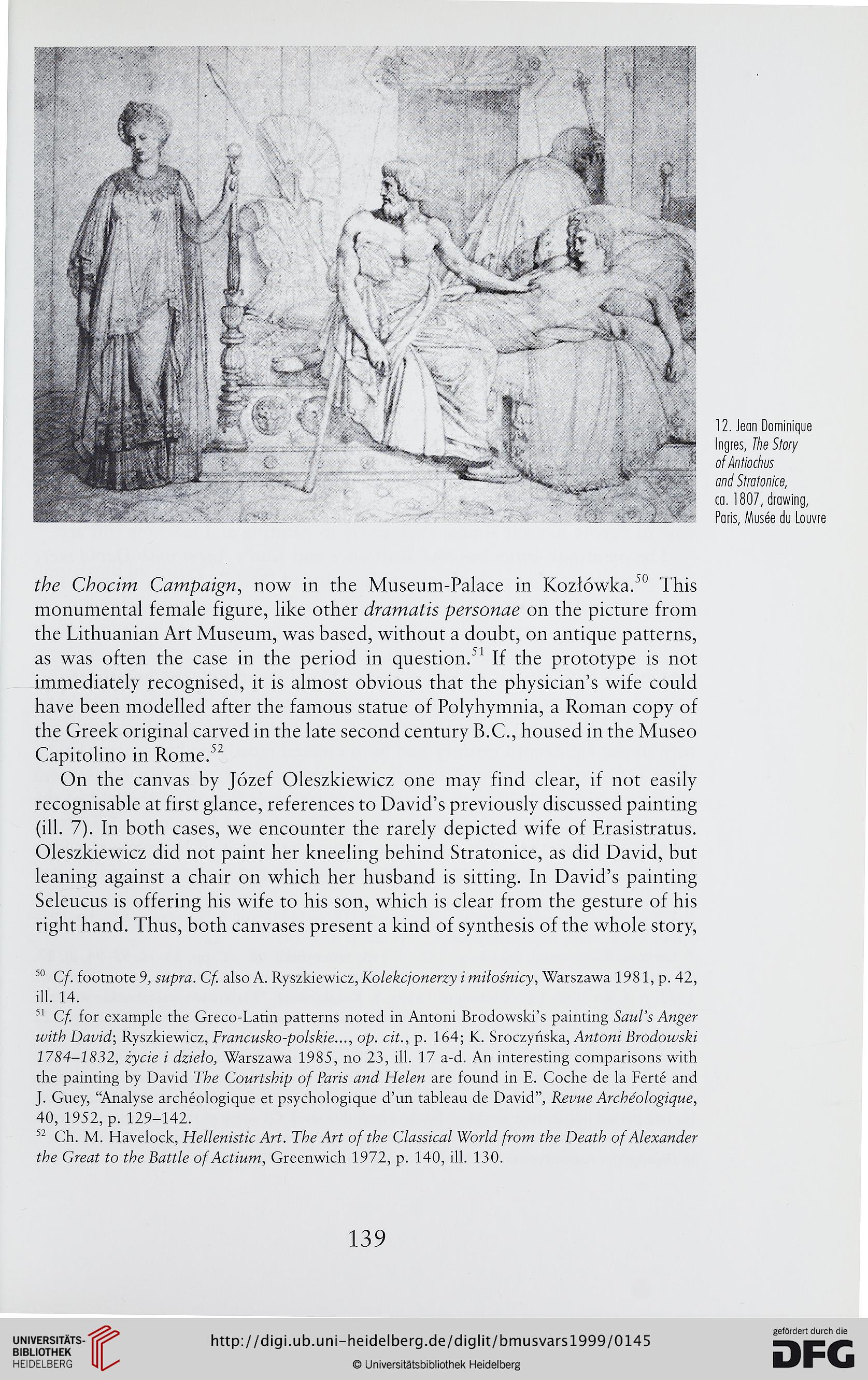12. Jean Dominique
Ingres, The Story
ofAntiochus
and Stratonice,
ca. 180/, drawing,
Paris, Musee du Louvre
the Chocim Campaign, now in the Museum-Palace in Kozłówka.'0 This
monumental female figurę, like other dramatis personae on the picture from
the Lithuanian Art Museum, was based, without a doubt, on antiąue patterns,
as was often the case in the period in ąuestion.50 51 52 If the prototype is not
immediately recognised, it is almost obvious that the physician’s wife could
have been modelled after the famous statuę of Polyhymnia, a Roman copy of
the Greek original carved in the late second century B.C., housed in the Museo
Capitolino in Romek2
On the canvas by Józef Oleszkiewicz one may find elear, if not easily
recognisable at first glance, references to David’s previously discussed painting
(ill. 7). In both cases, we encounter the rarely depicted wife of Erasistratus.
Oleszkiewicz did not paint her kneeling behind Stratonice, as did David, but
leaning against a chair on which her husband is sitting. In David’s painting
Seleucus is offering his wife to his son, which is elear from the gesture of his
right hand. Thus, both canvases present a kind of synthesis of the whole story,
50 Cf. footnote 9, supra. Cf. also A. Ryszkiewicz, Kolekcjonerzy i miłośnicy, Warszawa 1981, p. 42,
ill. 14.
51 Cf. for example the Greco-Latin patterns noted in Antoni Brodowski’s painting Saul’s Anger
with David-, Ryszkiewicz, Francusko-polskie..., op. cit., p. 164; K. Sroczyńska, Antoni Brodowski
1784-1832, życie i dzieło, Warszawa 1985, no 23, ill. 17 a-d. An interesting comparisons with
the painting by David The Courtship of Paris and Helen are found in E. Coche de la Ferte and
J. Guey, “Analyse archeologiąue et psychologiąue d’un tableau de David”, Reuue Archeologiąue,
40, 1952, p. 129-142.
52 Ch. M. Havelock, Hellenistic Art. The Art of the Classical World from the Death of Alexander
the Great to the Battle of Actium, Greenwich 1972, p. 140, ill. 130.
139
Ingres, The Story
ofAntiochus
and Stratonice,
ca. 180/, drawing,
Paris, Musee du Louvre
the Chocim Campaign, now in the Museum-Palace in Kozłówka.'0 This
monumental female figurę, like other dramatis personae on the picture from
the Lithuanian Art Museum, was based, without a doubt, on antiąue patterns,
as was often the case in the period in ąuestion.50 51 52 If the prototype is not
immediately recognised, it is almost obvious that the physician’s wife could
have been modelled after the famous statuę of Polyhymnia, a Roman copy of
the Greek original carved in the late second century B.C., housed in the Museo
Capitolino in Romek2
On the canvas by Józef Oleszkiewicz one may find elear, if not easily
recognisable at first glance, references to David’s previously discussed painting
(ill. 7). In both cases, we encounter the rarely depicted wife of Erasistratus.
Oleszkiewicz did not paint her kneeling behind Stratonice, as did David, but
leaning against a chair on which her husband is sitting. In David’s painting
Seleucus is offering his wife to his son, which is elear from the gesture of his
right hand. Thus, both canvases present a kind of synthesis of the whole story,
50 Cf. footnote 9, supra. Cf. also A. Ryszkiewicz, Kolekcjonerzy i miłośnicy, Warszawa 1981, p. 42,
ill. 14.
51 Cf. for example the Greco-Latin patterns noted in Antoni Brodowski’s painting Saul’s Anger
with David-, Ryszkiewicz, Francusko-polskie..., op. cit., p. 164; K. Sroczyńska, Antoni Brodowski
1784-1832, życie i dzieło, Warszawa 1985, no 23, ill. 17 a-d. An interesting comparisons with
the painting by David The Courtship of Paris and Helen are found in E. Coche de la Ferte and
J. Guey, “Analyse archeologiąue et psychologiąue d’un tableau de David”, Reuue Archeologiąue,
40, 1952, p. 129-142.
52 Ch. M. Havelock, Hellenistic Art. The Art of the Classical World from the Death of Alexander
the Great to the Battle of Actium, Greenwich 1972, p. 140, ill. 130.
139




